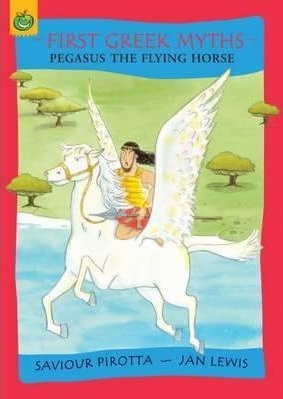Title of the work
Country of the First Edition
Country/countries of popularity
Original Language
First Edition Date
First Edition Details
Saviour Pirotta, Pegasus the Flying Horse, First Greek Myths. London: Orchard Books, a division of Hachette Children’s Books, 2008, 32 pp.
ISBN
Genre
Myths
Target Audience
Children (6–9)
Cover

Cover courtesy of the illustrator, Jan Lewis.
Author of the Entry:
Ayelet Peer, Bar-Ilan University, ayelet.peer@gmail.com
Peer-reviewer of the Entry:
Lisa Maurice, Bar-Ilan University, lisa.maurice@biu.ac.il
Elżbieta Olechowska, University of Warsaw, elzbieta.olechowska@gmail.com

Jan Lewis (Illustrator)
Jan Lewis has been a children’s books illustrator since 1978. She has a first class honours degree from Bath Academy of Art, and a Masters from Falmouth University. She illustrates books for various publishers.
Source:
Personal website (accessed: March 11, 2019).
Bio prepared by Ayelet Peer, Bar-Ilan University, ayelet.peer@gmail.com

Photo courtesy of the Author.
Saviour Pirotta
, b. 1958
(Author)
Saviour Pirotta is a Maltese-born children's author based in Britain. Before turning to writing he was a professional story-teller. He has a preference for retelling traditional myths and legends. Also he writes in English various kinds of books, both fiction and non-fiction, including educational books and story collections. His publications include The Orchard Book of Grimm's Fairy Tales (Orchard, 2001), the Ancient Greek Mystery series (Bloomsbury), and My Cousin the Minotaur (Fiction Express/ ReadZone Books, 2016). Among his awards are The Guardian's Children's Books of the Month, October 2018 for The Unicorn Prince; English Association Award, Best Non-Fiction Picture Book 1998 for A Seed In Need Winner; The Guardian, Best Children's Books 2016 for Perseus and Medea (QED Publishing).
Source:
Official website (accessed: June 1, 2022).
Bio prepared by Sonya Nevin, University of Roehampton, sonya.nevin@roehampton.ac.uk and Ayelet Peer, Bar-Ilan University, ayelet.peer@gmail.com
Summary
This book is part of an Easy-to Read series accompanied by colorful illustrations (Orchard Colour Crunchies). It is part of a ten-book series on Greek myths.
This story narrates the fight of Bellerophon and Pegasus against the Chimera. The story begins with a description of the monstrous Chimera and the king’s request to Bellerophon to neutralize it. Bellerophon consults a magician who advises him to catch the flying horse, Pegasus, in order to vanquish the Chimera. Bellerophon waits for Pegasus to appear and then uses the golden bridle as harness. Together they manage to kill the Chimera and bring peace to the land.
Analysis
Since this is an early reading book, the plot is very clear and condensed. There is no mention of Bellerophon’s background or his relations with the nameless king who asks him to kill the Chimera. The story aims to show the adventure of Pegasus and Bellerophon and how they captured the Chimera. A group of children are added, who help Bellerophon find Pegasus’ water spot, which introduces an element of relatability for the young readers. The author chose not to mention the gods; instead a magician helps Bellerophon and gives him the magical bridle. Perhaps the author did not wish to focus on the polytheistic gods and wanted to focus more on the human hero.
There is also no geographical orientation for the story, which adds to the fairytale mood of the book, in that it is now a tale of a monster who appears in a nameless country. Similarly, although the series is named First Greek Myths, there are no specific elements that connect this story to Greek mythology. The author perhaps thought that geography might confuse the children or just wished to keep the story more mysterious and fairy-tale like without any other links to mythology. In contrast, however, the illustrations feature ancient Greek-style attire, which does give an air of antiquity to the work .
There is no didactic emphasis in the book, except for the simple language. There is no reference to the bond between Bellerophon and Pegasus, who is treated as a magical animal, a horse with wings whom Bellerophon catches, but no more than this. The result is a clear and easily read adventure story for young readers.
Addenda
The entry is based on the 2009 paperback edition.


